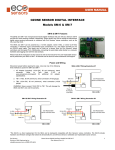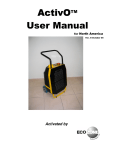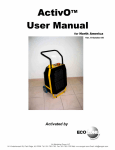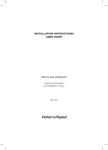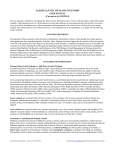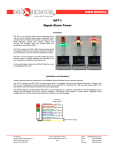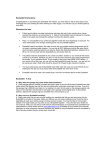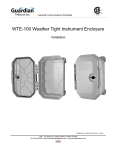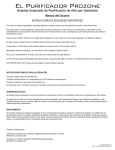Download EZ-1X EcoZone™ Ozone Monitor
Transcript
ECO SENSORS, INC. Portable Ozone Sensor EcoZone™ Model EZ‑1X OZONe SeNSOr INSTRUCTIONS FOR USE Ozone .14 Before you read further! Be sure that the EZ‑1X warms up for at least 15 minutes. It is highly recommended to warm‑up the EZ‑1X overnight if it has not been used for over a week or if it has been stored near chemicals. OZONe PPM level bar GraPH DISPlay There is no off‑on switch. To power up the instrument, simply plug in the AC adapter (12 volts DC). At least one bar on the display will light up. The first green bar is the “on” pilot light; any additional illuminated LED colors bars indicate ozone in the area. The EZ‑1X will require up to 3 minutes to change to a new reading when the ozone concentration changes or when the instrument has been moved from one place to another. FOR AC OPERATION: Put the switch in the AC Power & Bat Chg position. This is also the position for charging the batteries. FOR BATTERY OPERATION: Put the switch in the Battery position. The instrument will have up to 7 hours of usage from fully charged batteries. The batteries probably will have some charge when the instrument is delivered. Recharging fully discharged batteries will require 14 hours of AC operation (overnight) or about one hour of charging per 30 minutes of use. When the batteries are low, the first green bar (“on”) will start to get dim and it will begin to blink. Operation of the instrument should be concluded as soon as possible at this point ‑ within a minute or so to be sure ‑ because the battery decline thereafter can be very rapid. A first sign of too‑low batteries after the blinking starts is slower instrument response and higher readings. recharging the batteries: Put the switch down in the Bat Chg position. Warm-up is required with a major purpose being to “burn-off” trace chemicals that the sensor will absorb if it has been idle and not heated. Recommended EZ-1X warm-up times by either battery or AC adapter are: Warm-up Time 10 minutes 1 hour 24 hours Warm-up will not be required if the instrument is left plugged into its AC adapter and the switch is in the AC Power & Bat Chg position. SENSOR NOTES: • Sensor failure, which is the major maintenance item of the EZ‑1X, is indicated by the instrument always reading high. • Occasionally a mechanical shock to the Instrument will cause the reading to go to zero even in the presence of ozone. After about 5 minutes the sensor will gradually recover. FOR USE AROUND SMALL OZONE GENERATORS: See reverse side of this instruction sheet. data Readout LED Display ‑ This is a ten segment “bar graph” or “color bar” display that reads 4 green segments, three yellow segments, and three red segments. The first green segment serves as a pilot light to indicate that the instrument is receiving power and when blinking that there is a low battery condition. The second green segment comes on at .02 ppm of ozone, the first yellow at .05 ppm, the first red at .1 ppm, and the final red at over .14 ppm of ozone. The calibration is: BAR PPM of Ozone BAR PPM of Ozone 1st green “on” 2nd yellow .07 2nd green .02 3rd yellow .08 3rd green .03 1st red .10 4th green .04 2nd red .12 1st yellow .05 3rd red .14 Accuracy and Calibration The EZ‑1X calibration is shown above and is marked on the front face of the instrument. The instrument is most accurate in the .05‑.1 ppm range and should be within 20%. Below .05 ppm, the reading jumps significantly from bar to bar (for example 50% from the 2nd green to the 3rd green) and so the accuracy is correspondingly limited there. The instrument will respond to NOx and its derivatives, commonly found in outdoor air especially in the evening, and to the fumes of strong acids and chlorine compounds. Chlorine compound fumes around swimming pools during normal operation are not a problem. Specifications • • • • • • • POWer SOUrCe SeleCTION aC Power & bat Chg MODEL EZ‑1X EcoZone™ Monitor Operation • • • • • ON battery Ozone is easy to sense, but measurement can be very counter intuitive and tricky. The Eco Sensors® EZ‑1X makes ozone sensing and monitoring simple and inexpensive. The instrument is not a primary standard and is sold for general monitoring rather than precise measurements. It can be used outdoors for short periods at moderate temperatures. Time Since Last Powered 1 minute - 3 days 3 - 7 days more than 1 week .05 .03 0 Low Bat When Blinking General Description PPM .10 Sensor: Heated metal oxide semiconductor. Range: .02‑.14 ppm of ozone. Response time: 10’s of seconds to respond and somewhat longer to recover. Accuracy: within 20% in the .05‑.1 ppm range depending on the conditions. Recommended general function check: every three months. Recommended calibration check: every year. Temperature range: 15‑27 degrees C (60‑80 degrees F). Size: 85 X 35 X 60 mm (3 1/4” X 1 3/8” X 2 3/8”) Weight: 154 grams (6 oz.) Power requirement: 12 volts DC at 300‑500 mA. (120 volt 60 Hz. AC adapter supplied to North American customers) or self-contained rechargeable batteries. See Tech Note P‑101 for complete adapter specifications. Batteries: Self‑contained NiMH special design usable 2-7 hours depending on the average number of LED display segments illuminated. Fusing: Self‑resetting fuse that triggers at 250 mA. current or more than approximately 24 volts input. Has an overvoltage protection diode to eliminate supply voltage spikes and surges. Enclosure material: flame retardant ABS. Accessories P‑20 AC POWER ADAPTER OUTPUT 12 VDC 500 MA. CTR. + Service and Maintenance Please contact your distributor about service. In emergencies, the factory service number is (800) 472‑6626, and the e-mail is [email protected]. We recommend that the instrument be maintained and recalibrated annually. Factory service plans are available. Sensor ‑ The sensor is the only components of the instrument that is likely to fail or to require checkups. We recommend that the sensor be checked for satisfactory operation every three months, or more often in environments that are dusty, have high levels of chlorine or halogen compounds, or where there is dust or water spray. The sensor should be observed to see if it is responsive to changes in ozone level and if the ppm readings are reasonable. This can be done with the Eco Sensors model OG‑2 hand‑held ozone generator. Indications that the sensor is deteriorating or has failed are: • Its response is significantly lower. • The ozone concentration readings seem too high and tend to get even higher. • The instrument doesn’t respond at all and/or the bar graph does not go down to the green area after a brief warm‑up. Some of these problems can be compensated for by circuit adjustments or simple maintenance. Sensor replacement, however, requires an instrument technician and should be done by Eco Sensors or its authorized service representative. The replacement sensor is the model SE‑6A. Batteries ‑ The batteries are rechargeable NiMH. They should last several years. For a replacement battery pack (not available in stores) contact your distributor or Eco Sensors. AC Power Adapters ‑ AC adapters usually are burned out by power surges such as from lightning, but the EZ‑1X itself has protection against such surges. Replacement adapters for North American usage can be ordered from your distributor or Eco Sensors, Inc.; elsewhere suitable adapters can be purchased from local electronic stores. Specifications are found in our Tech Note P‑101. Precautions • Allow at least 15 minutes warm up, and better, an hour or more. If the instrument hasn’t been used for days or weeks, an overnight warm up will be helpful to “burn off” any contaminants that may have been absorbed by the sensor. • Read all instructions in this manual. • Keep instrument dry. Never let water or other liquids into the sensor. • Do not drop the instrument or subject it to continuous vibration. • Do not store or operate the instrument in high levels of dust. • Do not attempt to service the instrument yourself. You are likely to break the sensor which will be expensive and time consuming to replace. • Do not clean the instrument with cleaning chemicals or solvents. Clean it with a damp cloth or with ArmorAll™. • Do not operate the instrument near heavy aerosols (spray) usage or where oxygen is being administered. • The sensor element, which is very small, operates at a temperature of about 500 degrees C. (932 degrees F). Do not operate the instrument where this could be a problem. • Do not rely on readings where there is high concentrations of chlorine or other halogens (elemental or compounds), sulfur compounds, or acid gases are present. Consult with Eco Sensors or your distributor when there may be a problem. • Water is very damaging to the sensor element . Warranty This product is warranted against defects in materials and workmanship for one year following the date of purchase by the original owner. This warranty does not include damage to the product as a result of misuse, accident, damage, modifications, or alterations, and it does not apply if the instructions in this manual are not followed. If a defect develops during the warranty period, Eco Sensors at its election will repair the instrument or will replace it with a new or reconditioned model of equivalent quality. In the event of replacement with a new or reconditioned model, the replacement unit will continue the warranty of the original unit. To return the instrument contact your distributor, or call Eco Sensors at (800) 472-6626 or e-mail at: [email protected] to receive return instrument and a Return Goods Authorization (RGA) number. Except as provided herein, Eco Sensors makes no warranties, express or implied, including warranties of merchantability and fitness for a particular purpose. Eco Sensors shall not be liable for loss of use of this instrument or other incidental or consequential damages, expenses or economic loss, or claims for such damage or economic loss. This warranty gives you specific legal rights, and you may also have other rights which vary from state to state. Accessories for the EZ‑1X include: RECORD YOUR SERIAL NUMBER HERE____________________________________ OG‑3 Ozone Source Calibrator A portable, battery‑operated source of calibrating ozone at approximately .1 ppm. KEEP THIS MANUAL AND WARRANTY FOR YOUR RECORDS EE‑1 Environmental Enclosure An enclosure to protect the EZ‑1X from dust, water splashes, etc. It has a transparent front cover and air circulation fan. Eco Sensors is a registered trademark of Eco Sensors, Inc. EcoZone is a trademark of Eco Sensors, Inc. (c) Eco Sensors, Inc., 2000. (Over) Revision 1/03 WHY IT IS IMPORTANT TO MEASURE OZONE AT VARIOUS POINTS IN THE ROOM Ozone concentrations can vary greatly at various locations, and the concentrations are often highest in unexpected places. Key points to consider: • Ozone is much heavier than air and tends to sink to lower levels. • Ozone has a low vapor pressure and so it does not try to fill the room uniformly. It tends to stay where it is. • Ozone tends to cling to rough surfaces such as fabrics and breaks down (converts back to oxygen) when passing through restricted and obstructed passageways. • Ozone reverts back to oxygen with a “half life” (time to go to half its original amount) typically of 10‑30 minutes. • Ozone easily can be confused by instrumentation with other oxidizing gases such as chlorine compounds, acid fumes, and nitric oxides (NOx). Strong “reducing” gases, such as vapors of alcohol and solvents, can reduce the apparent concentration of ozone. • Ozone has a sweet smell, but the odor threshold varies widely by the person and by ambiental conditions. Therefore “smell” is not a reliable test for the presence or concentration of ozone. OZONE MAPPING AROUND A SMALL OZONE GENERATOR OZONE gENERATOR OZONE FLOW MAY NOT gO STRAIghT OUT FROM ThE OZONE gENERATOR. MAJOR CONCENTRATIONS MAY BE IN SIDE LOBES. SOME OZONE RETURNS TO ThE OZONE gENERATOR AIR INLET OZONE "FLOWS" ALONg TABLE TOP AND ThEN "FALLS" TO ThE FLOOR SOME OZONE REVERTS BACK TO OXYgEN The important measurement is: What is the ozone concentration at the breathing level where room occupants will be? For ozone introduced via HVAC systems, with good room air circulation, the alternate point of measurement is near the entrance to the return air duct. More information about our products and applications at: www.ecosensors.com






